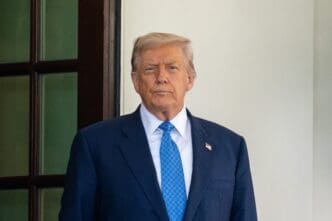Executive Summary
The Story So Far
Why This Matters
Who Thinks What?
Security guarantees for Ukraine are emerging as a central component to any potential deal that might end the ongoing conflict with Russia. While Ukraine’s aspirations for NATO membership, which would provide Article 5 assurances, remain on hold, President Trump’s point person for Kremlin talks, Steve Witkoff, has indicated that the U.S. could participate in “Article 5-like protections” for Ukraine.
President Trump recently acknowledged Russia’s agreement that the U.S. and European countries could provide security guarantees to Ukraine. However, he appeared to keep the nature of these assurances vague, downplaying the possibility of them being on par with NATO’s collective defense clause. During a meeting at the White House with Ukrainian President Volodymyr Zelensky and European leaders, Trump stated, “I don’t know if you define it that way — NATO-like.”
A spokesperson for the Russian Foreign Ministry has rejected the idea of deploying troops from NATO member states on Ukrainian soil. Meanwhile, President Zelensky has expressed a desire for the most comprehensive guarantees possible, interpreting “everything” to include Western troops on the ground, intelligence sharing, and a firm commitment to deliver military equipment.
America First Ideas
President Trump has relied on his special envoy for Ukraine, Keith Kellogg, in shaping his administration’s strategy on the war. Kellogg, an alumnus of the America First Policy Institute (AFPI), reportedly presented a plan to President Trump in June alongside AFPI fellow Frederick Fleitz, who previously served as chief of staff at the National Security Council during Trump’s first term. This plan aimed to bring President Zelensky and Russian President Vladimir Putin to the negotiating table.
Fleitz indicated to Reuters that “arming Ukraine to the teeth” was a part of the proposed security guarantees for Kyiv. This could be achieved through President Trump’s concept of selling U.S. weapons to NATO members, who would then transfer those weapons to Ukraine. President Trump reiterated this stance in the Oval Office, stating, “We’re not giving anything. We’re selling weapons,” while noting Europe would take the lead on the first line of defense with U.S. assistance.
‘Mainstream’ Security Ideas
Luke Coffey, a senior fellow at the Hudson Institute, proposed a five-layered security guarantee for Ukraine in an April report, describing it as a centrist approach that could garner support in Washington. Coffey stated that while he supports Ukraine’s NATO entry, a more realistic possibility is needed given President Trump’s position. This approach aims to provide meaningful U.S. support without significantly draining resources.
Under Coffey’s framework, U.S. forces could assist European countries in defending Ukraine through various means. These could include air-to-air refueling, intelligence sharing, Black Sea patrols, and the prepositioning of U.S. forces outside Ukraine for potential crisis deployment. Coffey also advocated for restarting the National Guard State Partnership Program with Ukraine, which was paused after Russia’s full-scale invasion in February 2022, suggesting it could be a way to gradually reintroduce U.S. personnel for training rotations.
Coffey expressed reservations about a bilateral U.S.-Ukraine security agreement, arguing that if the goal is to commit American troops to Ukraine’s defense, direct NATO membership would be a more logical step.
‘Realism and Restraint’
The Quincy Institute, established in 2019 to promote policy ideas centered on “realism and restraint,” offers another perspective. According to Episkopos, Article 5-like guarantees for Ukraine could involve an enhancement of existing support, with “some additional steps.” These potential measures might include the implementation of a no-fly zone, the provision of more advanced weaponry, and limited rearguard deployments of European troops.
MAGA Isolationists
Within the political spectrum, some voices advocate for a more isolationist approach regarding Ukraine. For instance, Rep. Marjorie Taylor Greene (R-Ga.) posted on social platform X in July, stating, “I’ve never voted to send a single penny to Ukraine. I’ve only called for peace.”
As discussions continue, the exact nature and scope of security guarantees for Ukraine remain a subject of varied proposals and ongoing negotiation, with a focus on finding a viable path to end the conflict in the absence of immediate NATO membership.








